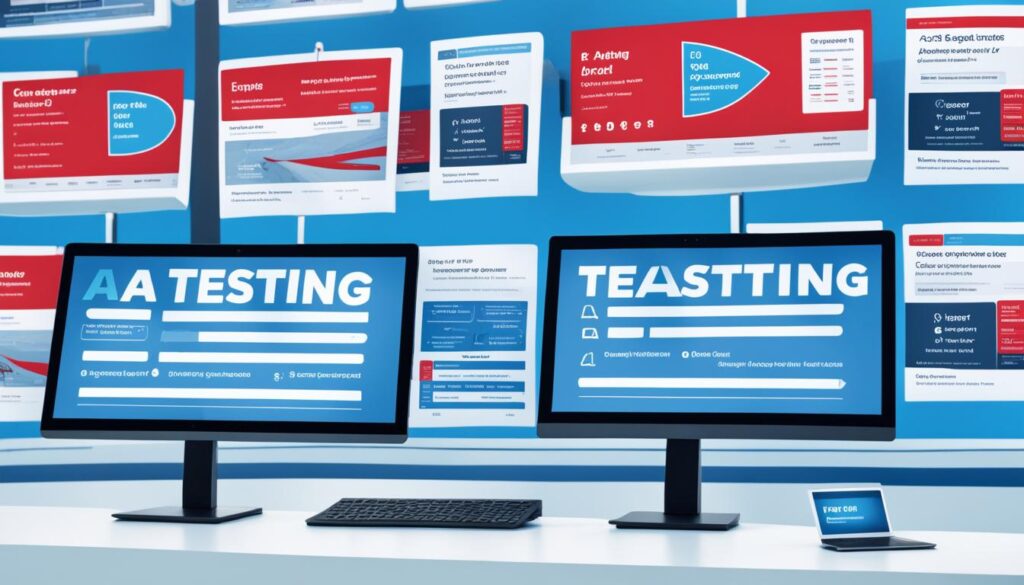In today’s digital landscape, data is power. As a marketer, you can no longer rely solely on instinct and guesswork to drive your marketing campaigns. Enter digital marketing analytics, the game-changer that revolutionizes how you optimize and measure the success of your campaigns.
Digital marketing analytics involves the use of analytics tools, such as web analytics and data analytics, to analyze data and gain valuable insights into your marketing campaigns. These insights provide a deeper understanding of your audience, their behavior, and the effectiveness of your marketing strategies.
With tools like Google Analytics, you can track various metrics, such as conversion rate and website traffic, to assess the performance of your campaigns. By analyzing this data, you can identify areas for improvement and optimize your marketing efforts accordingly.
Digital marketing analytics empowers marketers to make data-driven decisions and take proactive steps to enhance their campaigns. The ability to analyze data in real-time allows for quick adjustments and optimization, leading to more effective and targeted marketing efforts.
By leveraging digital marketing analytics, you can:
- Gain valuable insights into your target audience and their preferences.
- Optimize your marketing strategies to maximize ROI.
- Analyze data to identify trends and make data-driven decisions.
- Track the performance of your marketing campaigns in real-time.
- Use digital marketing analytics tools to measure the success of your campaigns.
With digital marketing analytics, you can unlock the true potential of your marketing campaigns and drive meaningful results. Are you ready to harness the power of data and take your marketing efforts to the next level?
Key Takeaways:
- Digital marketing analytics provides valuable insights into your audience and campaign performance.
- Analytics tools like Google Analytics help track metrics and optimize marketing strategies.
- Real-time data analysis enables quick adjustments and optimization for better results.
- Using digital marketing analytics tools allows you to measure the success of your campaigns.
- Data-driven decisions based on insights drive meaningful results in marketing campaigns.
The Power of Real-Time Data Analytics in Digital Advertising
Real-time data analytics is a game-changer in the world of digital advertising. It enables marketers to optimize their campaigns and achieve remarkable results. By harnessing the power of data, advertisers can fine-tune their strategies, reach the right audience, and drive conversions like never before.
One of the key aspects where real-time data analytics excels is in optimizing digital advertising through programmatic advertising. Programmatic advertising automates ad inventory transactions, ensuring efficiency and precise targeting. It allows advertisers to deliver ads at the perfect moment, reaching potential customers with messages tailored to their interests and needs.
The efficiency boost provided by programmatic advertising is unparalleled. Through real-time data analytics, advertisers can analyze consumer behavior, identify patterns, and make data-driven decisions. This creates a seamless process that eliminates guesswork and maximizes returns on advertising investments.
“Real-time data analytics allows advertisers to deliver highly targeted ads, resulting in improved engagement and conversions.” – Marketing Expert
Real-time optimization is another significant advantage that comes with leveraging data analytics in digital advertising. Advertisers can monitor the performance of their campaigns in real-time and make prompt adjustments to optimize results. By continuously refining targeting parameters, ad creatives, and delivery strategies, advertisers can ensure their ads are always relevant and effective.
Furthermore, real-time data analytics provides transparent insights into ad placement, allowing advertisers to evaluate the performance of their ad placements across various channels. This transparency enables them to identify the most effective channels and allocate their advertising budgets accordingly. With this level of insight, advertisers can optimize their digital advertising efforts and achieve scalable reach.
The Benefits of Real-Time Data Analytics in Digital Advertising
Real-time data analytics offers numerous benefits to advertisers, including:
- Optimized digital advertising through programmatic advertising
- Efficiency boost and precise targeting
- Real-time optimization for better results
- Transparent insight into ad placement
- Scalable reach across various channels
By harnessing the power of real-time data analytics, advertisers can unlock the full potential of their digital advertising campaigns. With accurate insights, precise targeting, and real-time optimization, brands can drive meaningful engagement, increase conversions, and achieve their marketing objectives.
Data-Driven Success: A Real-Life Example
“In a recent advertising campaign, XYZ Company utilized real-time data analytics to optimize their digital advertising efforts. By analyzing real-time data, they were able to identify the most effective channels, refine their creative messaging, and deliver highly targeted ads to their audience. As a result, they experienced a 30% increase in click-through rates and a 20% boost in conversion rates, surpassing their initial campaign goals.” – Marketing Case Study
The example above highlights the power of real-time data analytics in orchestrating successful digital advertising campaigns. With transparent insights, precise targeting, and real-time optimization, advertisers can achieve remarkable results and drive their businesses forward.
A/B Testing and its Impact on Digital Advertising

A/B testing is a powerful strategy that involves comparing different versions of websites, apps, or ads to determine which performs better. By conducting A/B tests, marketers can gather valuable data and insights to optimize their digital advertising campaigns.
One of the key drivers behind successful A/B testing is the use of AI-driven tools. These tools enable seamless testing and automate the process of monitoring campaign performance. By continuously analyzing data and metrics, AI-driven tools can identify underperforming ads and make automatic adjustments in real-time.
Not only does A/B testing help improve the overall performance of digital advertising campaigns, but it also plays a crucial role in elevating targeting and personalization. By testing different variations of ads, marketers can identify the best-performing elements, such as visuals, headlines, or calls to action, and tailor their campaigns to better reach and engage their target audience.
Implementing A/B testing and leveraging AI-driven tools can have a significant impact on the success of digital advertising campaigns. It allows marketers to optimize their ads based on concrete data and insights, resulting in higher conversion rates and better ROI.
Benefits of A/B Testing in Digital Advertising:
- Improved ad performance and effectiveness
- Increased conversion rates and ROI
- Enhanced targeting and personalization
- Data-driven decision making
Real-time A/B testing empowers marketers to make data-driven decisions and optimize their digital advertising campaigns for maximum impact.
| Key Elements to Test | Performance Metrics to Track |
|---|---|
| Ad headlines | Click-through rate (CTR) |
| Call to action (CTA) | Conversion rate |
| Visuals and graphics | Engagement rate |
| Ad placement | Cost per acquisition (CPA) |
The Influence of Personalized Ad Delivery in Digital Advertising

Personalized ad delivery is a game-changer in the world of digital advertising. Leveraging real-time data, marketers can customize advertisements, email campaigns, and promotional offerings to cater to specific customer segments. This approach provides a consumer-centric advantage and allows brands to offer tailored experiences across generations, resulting in amplified engagement and loyalty.
“With personalized ad delivery, brands can create meaningful connections with their target audience by delivering relevant and personalized content. By understanding consumer preferences and behavior through real-time data, advertisers can deliver ads that resonate with individuals on a deeper level.”
One of the key benefits of personalized ad delivery is its ability to optimize advertising efforts based on real-time insights. By analyzing customer data in real-time, marketers can deliver highly targeted ads, ensuring that their message reaches the right audience at the right time. This personalized approach not only enhances brand perception but also increases the chances of conversion, ultimately driving revenue growth.
Moreover, personalized ad delivery allows brands to build long-lasting relationships with their customers. By delivering tailored experiences that align with customers’ interests and preferences, brands can foster stronger engagement and loyalty. This personalized approach creates a sense of connection and makes customers feel valued and understood, leading to increased customer satisfaction and repeat purchases.
Personalized ad delivery also offers the advantage of reaching consumers across multiple generations. With insights gained from real-time data, brands can create personalized experiences that cater to the unique needs and preferences of different age groups. This tailored approach not only helps brands connect with their target audience but also enables them to adapt their messaging and creative to effectively engage each generation.
To illustrate the impact of personalized ad delivery, consider the following example:
| Traditional Advertising | Personalized Ad Delivery |
|---|---|
| One-size-fits-all approach | Customized messages based on specific customer preferences |
| Generic content | Relevant and personalized content for each individual |
| Low engagement and conversion rates | High engagement and conversion rates |
| Limited customer insights | Deeper understanding of customer preferences and behavior |
Data-Driven Marketing: Collecting and Analyzing Data for Success

Data-driven marketing has become a cornerstone of modern marketing strategies. By collecting and analyzing data, businesses can uncover valuable insights that inform their decision-making processes. To achieve success in data-driven marketing, it is essential to utilize effective data collection methods and leverage powerful analytics tools.
There are various sources from which businesses can collect data to fuel their marketing efforts. Website analytics provide valuable information about user behavior, traffic sources, and conversion rates. Customer surveys offer direct insights into consumer preferences, opinions, and satisfaction levels. Social media channels enable businesses to tap into real-time conversations and gather valuable feedback. By combining data from these sources and others, businesses can gain a comprehensive understanding of their target audience.
Once data is collected, the next step is to analyze it using dedicated analytics tools. These tools help businesses process and interpret the data, uncovering valuable customer insights. By examining patterns, trends, and correlations within the data, businesses can identify opportunities for optimization and targeting. Analytics tools also enable businesses to measure the success of their marketing campaigns, track key metrics, and make data-driven decisions to improve performance.
Here is an example of how businesses can utilize customer data and analytics tools to gain valuable insights:
| Customer Segment | Demographics | Interests |
|---|---|---|
| New Moms | Women, aged 25-34 | Parenting, baby products, health and wellness |
| Tech Enthusiasts | Men and women, aged 18-35 | Gadgets, technology trends, gaming |
| Outdoor Enthusiasts | Men and women, aged 35-55 | Hiking, camping, adventure sports |
By analyzing data on customer demographics and interests, businesses can tailor their marketing messages and campaigns to specific customer segments, ensuring relevance and higher engagement.
Data-driven marketing empowers businesses to make informed decisions, optimize their marketing strategies, and deliver personalized experiences to their target audience. It provides a competitive advantage in today’s digital landscape, where customers expect relevant and tailored interactions. By harnessing the power of data collection and analysis, businesses can drive success and achieve their marketing goals.
The Role of AI in Digital Marketing Analysis

Artificial Intelligence (AI) has become an indispensable tool in the realm of digital marketing analysis. Its capabilities in data processing and management, coupled with its ability to capture customer insights, have revolutionized the way businesses optimize their marketing strategies. AI empowers marketers to leverage advanced techniques like machine learning, natural language processing, computer vision, predictive analytics, deep learning, robotic process automation, and chatbots to drive meaningful results.
Enhanced Data Processing and Management
AI technologies enable efficient data processing and management, allowing businesses to handle large volumes of data effortlessly. By automating data processing tasks, AI algorithms can sift through vast amounts of information, identifying patterns, trends, and anomalies in real-time. This streamlined approach enables marketers to make data-driven decisions quickly and effectively.
Capturing Customer Insights
AI plays a crucial role in capturing valuable customer insights that go beyond superficial data. Through machine learning algorithms, AI models can analyze customer behavior, preferences, and engagement patterns to uncover deep-seated motivations and preferences. These insights provide marketers with a deeper understanding of their target audience, enabling them to tailor their strategies accordingly.
“AI empowers marketers to leverage advanced techniques like machine learning, natural language processing, computer vision, predictive analytics, deep learning, robotic process automation, and chatbots to drive meaningful results.”
Advanced Analytical Techniques
AI facilitates the application of advanced analytical techniques in digital marketing analysis. Machine learning algorithms can sift through vast amounts of data to identify patterns and correlations, providing marketers with predictive analytics capabilities. Natural language processing enables sentiment analysis and automated text analysis, helping businesses gauge customer perception and sentiment towards their brand. Computer vision allows for image and video analysis, providing valuable insights into visual content. These advanced techniques empower marketers to extract meaningful and actionable insights from their data.
Driving Personalization and Automation
AI-powered technologies like chatbots and robotic process automation enable personalized and automated marketing experiences. Chatbots utilize natural language processing and machine learning to engage with customers, providing quick responses and tailored recommendations. Robotic process automation automates repetitive tasks, freeing up marketers’ time to focus on high-impact activities. These capabilities enhance customer experiences and drive efficiency within marketing operations.
Overall, AI is a game-changer in digital marketing analysis. Its ability to handle data processing, capture customer insights, leverage advanced analytical techniques, and drive personalization and automation revolutionizes the way businesses optimize their marketing efforts. As AI continues to evolve, it will undoubtedly play a pivotal role in shaping the future of digital marketing.
| AI in Digital Marketing Analysis | Benefits |
|---|---|
| Data Processing and Management | – Streamlined processing of large volumes of data – Real-time identification of patterns and trends |
| Capturing Customer Insights | – Deeper understanding of target audience – Personalized marketing strategies |
| Advanced Analytical Techniques | – Predictive analytics for data-driven decisions – Sentiment analysis and visual content insights |
| Driving Personalization and Automation | – Enhanced customer experiences – Efficiency in marketing operations |
Benefits of Data-Driven Marketing Analysis

Data-driven marketing analysis provides marketers with a wealth of benefits, leveraging real-time data analysis, improved customer targeting, and personalization at scale. By harnessing the power of data, marketers can make informed decisions quickly, optimize their campaigns, and deliver impactful experiences to their customers.
Real-Time Data Analysis
Real-time data analysis is a game-changer in the world of marketing. It enables marketers to monitor campaign performance, identify trends, and make data-driven decisions on the fly. With real-time insights, marketers can optimize their strategies and messaging in real-time to maximize their campaign’s effectiveness.
Improved Customer Targeting
One of the key advantages of data-driven marketing analysis is the ability to improve customer targeting. By analyzing customer data, marketers can gain deep insights into consumer preferences, behaviors, and demographics. This allows them to create targeted campaigns that resonate with specific customer segments, increasing the likelihood of engagement and conversions.
Personalization at Scale
Another benefit of data-driven marketing analysis is the ability to personalize marketing efforts at scale. With a comprehensive understanding of customer data, marketers can tailor their messaging, offers, and experiences to individual customers, creating a personalized journey that drives engagement and builds loyalty.
| Benefits of Data-Driven Marketing Analysis |
|---|
| Real-Time Data Analysis |
| Improved Customer Targeting |
| Personalization at Scale |
Implementing Data-Driven Marketing Analysis in Your Business

Implementing data-driven marketing analysis in your business can significantly enhance your marketing campaigns and drive better results. To effectively leverage data-driven marketing, consider the following steps:
1. Collect Data from Relevant Sources
Start by collecting data from various sources, such as website analytics, customer surveys, social media platforms, and email campaigns. Gathering data from these sources will provide you with valuable insights into customer behavior, preferences, and purchasing patterns.
2. Choose the Right Analytics Tools
Selecting the appropriate analytics tools is crucial for efficient data analysis. There are numerous marketing analytics tools available, including Google Analytics, Adobe Analytics, and Kissmetrics. Evaluate your business needs and choose the tool that best suits your requirements, enabling you to track key metrics, measure campaign performance, and gain meaningful insights.
3. Define Your Target Audience
Defining your target audience is essential for effective data-driven marketing. By understanding your audience’s demographics, interests, and preferences, you can tailor your marketing strategies to resonate with their needs and desires. This approach enables you to personalize your campaigns and achieve better engagement and conversion rates.
4. Analyze the Collected Data
Once you have collected data and defined your target audience, it’s time to analyze the information to uncover valuable insights. Utilize your chosen analytics tools to dissect the data, identify trends, and discover patterns that can inform and optimize your marketing strategies. By analyzing the data, you can make data-driven decisions and improve the effectiveness of your campaigns.
5. Monitor Campaign Performance in Real-Time
Continuous monitoring of campaign performance is crucial for data-driven marketing success. Keep track of key metrics, such as conversion rates, click-through rates, and engagement levels, in real-time. This monitoring enables you to identify underperforming areas and take immediate action to optimize your campaigns and maximize results.
“Data-driven marketing implementation requires a systematic approach of collecting, analyzing, and utilizing data to inform marketing decisions. By incorporating data analysis into your marketing strategy, you can gain a competitive edge and drive better business outcomes.” – Sarah Johnson, Marketing Analyst
By implementing data-driven marketing analysis in your business, you can strategically leverage data to optimize your marketing campaigns, achieve higher conversion rates, and deliver personalized experiences to your target audience. Embrace the power of data-driven marketing to stay ahead of the competition and drive meaningful business growth.
| Benefits of Implementing Data-Driven Marketing Analysis |
|---|
| 1. Improved Decision Making |
| 2. Enhanced Customer Targeting |
| 3. Personalization at Scale |
| 4. Higher Conversion Rates |
| 5. Optimized Marketing Campaigns |
Digital marketing professionals understand the importance of leveraging digital analytics to measure and optimize marketing efforts across various digital channels. By utilizing web analytics tools and social media analytics, marketers can gather data from multiple sources, including customer data and website traffic, to provide insights into the effectiveness of digital marketing campaigns. These analytics help marketing teams make data-driven decisions and optimize marketing activities to improve the customer journey and enhance the overall digital strategy. With the power of digital marketing analytics, marketers can gather accurate data, analyze it comprehensively, and make informed decisions to optimize marketing investments and grow their business effectively. Whether it’s through understanding this data to improve digital advertising, leveraging analytics for online marketing initiatives, or utilizing marketing automation to streamline processes, digital marketing analytics allows marketers to harness the full potential of the digital space and shape the future of digital marketing.
Also Read : Boost Your Business Growth with a Digital Marketing Strategist
Conclusion
Data-driven marketing is the future of successful marketing campaigns. By harnessing the power of BI tools and leveraging ongoing technological advancements like AI, marketers can unlock valuable insights and optimize their marketing efforts for better results.
The future of data-driven marketing lies in its ability to transform raw data into actionable insights. BI tools provide marketers with the means to collect, analyze, and visualize data, empowering them to make informed decisions and drive effective marketing strategies.
With the continued evolution of AI, data-driven marketing analysis will become even more sophisticated. AI-powered algorithms can process large volumes of data, identify patterns, and deliver real-time recommendations, enabling marketers to optimize their campaigns and reach their target audience more effectively.
As the marketing landscape continues to evolve, embracing data-driven marketing and leveraging BI tools will be crucial for staying ahead of the competition. By unlocking the power of data, marketers can uncover hidden opportunities, gain a deeper understanding of their customers, and create personalized experiences that drive engagement and loyalty.
FAQs
Q: What is digital marketing analytics?
A: Digital marketing analytics involves the collection, measurement, and analysis of digital data to evaluate the performance of marketing campaigns and make informed decisions to drive business growth.
Q: How can digital marketing analytics benefit my business?
A: Digital marketing analytics can provide insights into customer behavior, preferences, and trends, helping you optimize marketing strategies, enhance customer experience, and increase return on investment.
Q: What are some common marketing analytics tools used in digital marketing?
A: Popular marketing analytics tools include Google Analytics, Adobe Analytics, HubSpot, and Salesforce Marketing Cloud, which offer advanced features for tracking and analyzing digital marketing data.
Q: Why is it important to use digital marketing analytics for my campaigns?
A: Digital marketing analytics can help you measure the success of your marketing efforts, identify areas for improvement, and align your strategies with your business goals, leading to more effective and efficient campaigns.
Q: How can digital marketing analytics help in optimizing digital strategy?
A: By analyzing digital metrics and performance data, digital marketing analytics can provide valuable insights to refine digital strategy, improve targeting, and enhance customer engagement for better results.
Q: What does the future of digital marketing analytics look like?
A: The future of digital marketing analytics is set to be more data-driven, AI-powered, and focused on real-time insights, enabling marketers to make informed decisions and adapt quickly to the changing digital landscape.
Q: How can digital marketing analytics help maximize the effectiveness of marketing channels?
A: With digital marketing analytics, you can measure the performance of various marketing channels, such as social media, email marketing, and content marketing, to allocate resources effectively and improve overall marketing ROI.
Q: What type of data can be collected and analyzed using digital marketing analytics?
A: Digital marketing analytics can collect and analyze data related to website traffic, customer interactions, conversion rates, marketing attribution, and user demographics, among other valuable metrics.
Q: How can digital marketing analytics help in optimizing marketing budget?
A: By providing insights into the performance and efficiency of marketing activities, digital marketing analytics can help allocate resources more effectively, identify cost-saving opportunities, and maximize the impact of your marketing budget.
Q: How can digital marketing analytics aid in improving digital marketing and advertising strategies?
A: Digital marketing analytics can help in evaluating the effectiveness of digital marketing and advertising efforts, enabling data-driven decision-making to refine strategies, enhance targeting, and create more impactful campaigns.
Source Links
- https://brianchristner.io/how-data-driven-marketing-is-revolutionizing-digital-marketing/
- https://www.linkedin.com/pulse/revolutionizing-digital-advertising-real-time-dynamic-sid-mehandru?trk=article-ssr-frontend-pulse_more-articles_related-content-card
- https://www.adaptiveus.com/blog/ai-digital-marketing-analysis/
